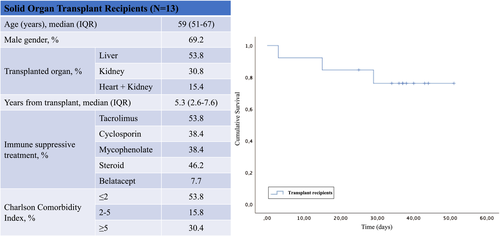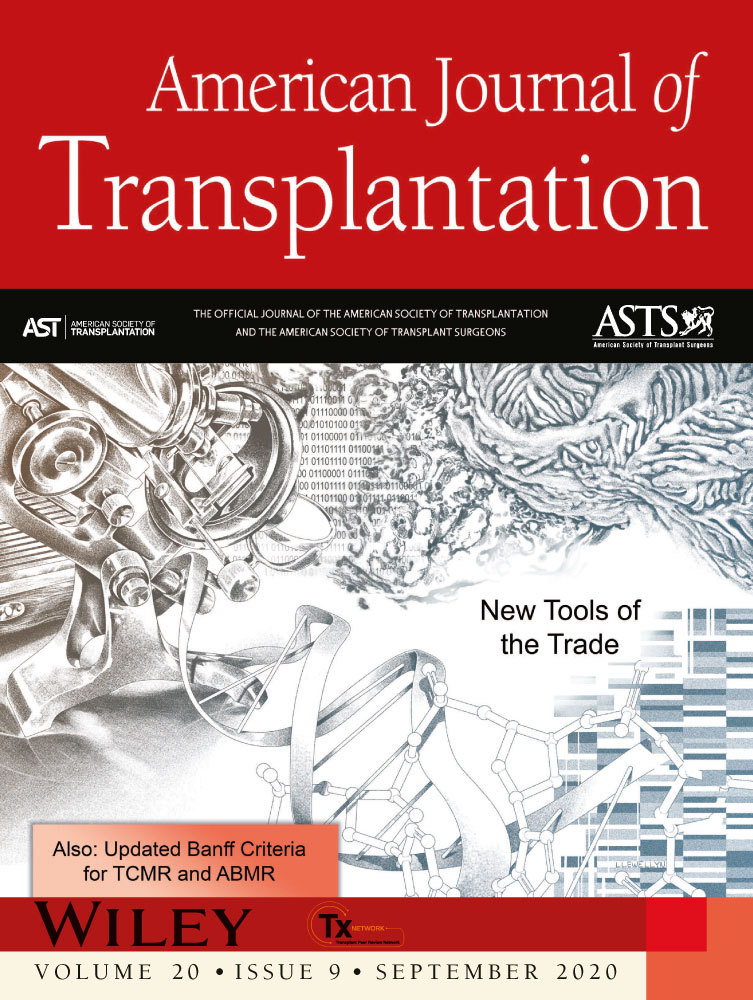Clinical outcome in solid organ transplant recipients with COVID-19: A single-center experience
To the Editor:
We read with great interest the report by Fernandéz-Ruiz et al1 on the outcome of 18 transplant recipients with COVID-19 showing a higher case-fatality rate than that reported in the general population. Unlike these authors, we did not observe a higher mortality in the transplant setting compared with our overall mortality. We collected data on 13 consecutive solid organ transplant recipients admitted to our center for COVID-19 between February 21 and April 26, 2020, with a median follow-up of 36 days (IQR 25-41). Our patients were younger (median age 59 vs 71 years) and had a shorter median interval from transplant (5.3 vs 9.3 years) than the patients in the Spanish case series. The most common comorbidities were hypertension (54%) and diabetes (31%).
At the time of COVID-19 diagnosis, all patients except 1 were taking calcineurin inhibitors (CNIs) with or without mycophenolate mofetil (MMF) and/or prednisone. The management of immunosuppressive treatment was not homogeneous: 3 of 5 patients stopped MMF; 1 patient received half the MMF dosage, increasing steroid therapy; and 4 additional patients stopped taking CNIs, increasing steroid therapy.
At first clinical evaluation, just 3 subjects had Spo2/Fio2 < 300 mm Hg; 9 subjects developed respiratory failure: the majority (n = 5) required only low-flow oxygen therapy, whereas 2 patients needed continuous positive airways pressure (C-PAP) and 1 required bilevel ventilation. Only 1 patient required mechanical ventilation.
Based on regional guidelines, drug–drug interactions, and electrocardiographic findings, 8 patients were treated with hydroxychloroquine, 3 with hydroxychloroquine and lopinavir/ritonavir, and 1 with remdesivir. Immunomodulatory treatment was used in patients with persistent fever and progressive respiratory distress: 3 patients were treated with high-dose steroids (≥1 mg/kg daily for 5 days) and 2 with tocilizumab (8 mg/kg). Prophylactic dose of low-molecular-weight heparin was administered to all patients. No patients experienced septic or bleeding complications.
Figure 1 shows the Kaplan-Meier curve for overall survival. Three patients (20%) died but only 1 death was related to COVID-19 respiratory failure, whereas in the other 2 cases, death was neoplasia related (pancreatic metastatic carcinoma and non-Hodgkin lymphoma). Compared with our overall in-hospital mortality, the case-fatality rate in transplant recipients was similar to that observed in the general population (20% vs 17%, χ2 test 0.059, P = .807).

In our experience, CNI tapering or withdrawal did not halt deterioration of respiratory failure, suggesting that its maintenance may partially prevent immune activation and the cytokine storm believed to be the driver of the most serious clinical pictures.2-4 Interestingly, 2 patients with a recent liver transplant (<2 months before the infection), both treated with 2 doses of basiliximab and high-dose methylprednisolone as induction therapy, did not develop any significant symptom or radiological abnormalities. In conclusion, we did not see a higher mortality in solid organ transplant recipients with COVID-19 and comorbidities appear to play a significant role in the outcome of COVID-19 in this subpopulation, as recently suggested by others.5 Finally, a better understanding of the pathophysiology of the disease may improve our tailoring of immunomodulation in this specific setting.
DISCLOSURE
The authors of this manuscript have no conflicts of interest to disclose as described by the American Journal of Transplantation.




